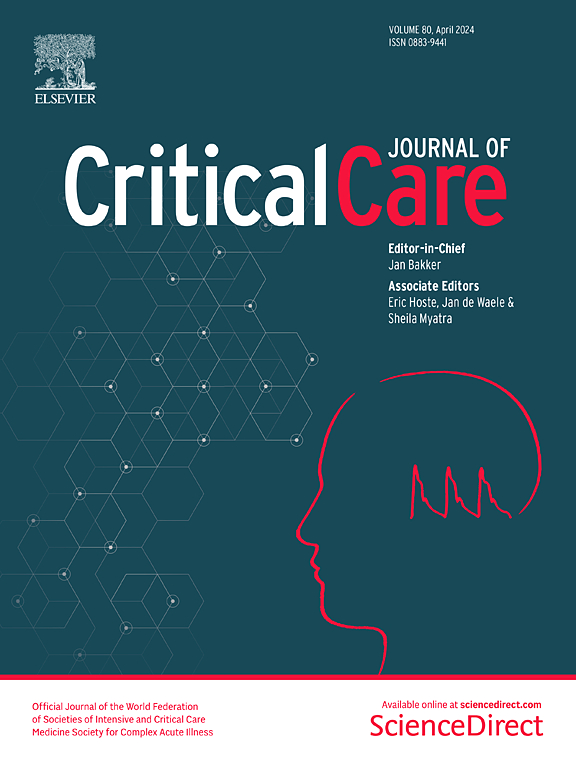Prevalence, risk factors and consequences of early clinical deterioration under non-invasive ventilation in emergency department patients: a prospective, multicentre, observational study of the French IRU Network
IF 8.8
1区 医学
Q1 CRITICAL CARE MEDICINE
引用次数: 0
Abstract
Non-invasive ventilation (NIV) is widely used in emergency settings for acute respiratory failure, with NIV failure, usually defined by the need for tracheal intubation, as its primary complication. In emergency settings where patients may not be intubated or or where NIV represents the ceiling of care, a pragmatic understanding of NIV failure requires a broader definition that incorporates early clinical deterioration, including presumptive intubation criteria. This study assessed the prevalence of early clinical deterioration under NIV initiated in emergency settings (emergency department [ED] or mobile emergency medical services [EMS]) and its associated variables. A prospective multicentre study was conducted in 68 French EDs and EMS in the Initiative Recherche Urgences (IRU) network. Adult patients (≥ 18 years) requiring NIV in emergency settings were included, excluding those with a known do-not-resuscitate order or low autonomy. The primary endpoint was early clinical deterioration under NIV at 1 h. Early clinical deterioration under NIV was defined as either (1) the need for tracheal intubation or; (2) the presence of presumptive criteria for intubation. Secondary endpoints were baseline factors associated with failure, the need for tracheal intubation or death within 7 days among patients surviving without tracheal intubation at 1 h, and 7-day mortality. A total of 198 patients were included over 5 days. Early clinical deterioration at 1 h was reported in 41% of the patients. Early clinical deterioration under NIV was associated with a Glasgow Coma Scale score < 14 (adjusted odds ratio [aOR] = 5.5, 95% confidence interval [CI] [1.8 –19.4]), heart rate > 115 beats per minute (aOR = 2.5, 95%CI [1.3–5.2]), and signs of increased work of breathing (aOR = 2.8, 95%CI [1.2–7.1]). Among the surviving patients not intubated at 1 h, 12% required intubation within 7 days in the Early Clinical Deterioration group and 3% in the No Early Clinical Deterioration group (p < 0.001). Within 7 days, 28% died in the Early Clinical Deterioration group and 10% in the No Early Clinical Deterioration group (p = 0.001). NIV failure was associated with increased 7-day mortality (aHR = 4.1, 95%CI [1.8–9.1]). Early clinical deterioration under NIV is common in EDs, affecting nearly one out of two patients, and is associated with higher 7-day mortality. Clinical trial registration Registered 2024 january, 23th. NCT06213623. Prior to the first inclusion.急诊科患者在无创通气下早期临床恶化的患病率、危险因素和后果:法国IRU网络的一项前瞻性、多中心观察性研究
无创通气(NIV)被广泛应用于急性呼吸衰竭的急诊环境,无创通气失败通常被定义为需要气管插管,是其主要并发症。在紧急情况下,患者可能没有插管,或者NIV代表了护理的上限,对NIV失败的务实理解需要更广泛的定义,包括早期临床恶化,包括假定的插管标准。本研究评估了急诊环境(急诊科[ED]或流动急救医疗服务[EMS])中NIV引发的早期临床恶化的发生率及其相关变量。一项前瞻性多中心研究在68个法国急症研究(IRU)网络的急诊室和EMS中进行。纳入了在紧急情况下需要使用NIV的成年患者(≥18岁),排除了那些已知有不复苏命令或自主性低的患者。主要终点是在NIV下1小时的早期临床恶化。NIV下的早期临床恶化被定义为(1)需要气管插管或;(2)存在插管的推定标准。次要终点是与失败相关的基线因素,需要气管插管或在1小时没有气管插管存活的患者在7天内死亡,以及7天死亡率。在5天内共纳入198例患者。41%的患者报告了1小时的早期临床恶化。在NIV下的早期临床恶化与格拉斯哥昏迷量表评分为每分钟115次(aOR = 2.5, 95%CI[1.3-5.2])和呼吸功增加的迹象(aOR = 2.8, 95%CI[1.2-7.1])相关。在1 h未插管的存活患者中,早期临床恶化组在7天内需要插管的患者占12%,无早期临床恶化组占3% (p < 0.001)。7天内,早期临床恶化组死亡28%,无早期临床恶化组死亡10% (p = 0.001)。NIV失效与7天死亡率增加相关(aHR = 4.1, 95%CI[1.8-9.1])。NIV下的早期临床恶化在急诊科很常见,影响近1 / 2的患者,并与较高的7天死亡率相关。临床试验注册2024年1月23日注册。NCT06213623。在第一次包含之前。
本文章由计算机程序翻译,如有差异,请以英文原文为准。
求助全文
约1分钟内获得全文
求助全文
来源期刊

Critical Care
医学-危重病医学
CiteScore
20.60
自引率
3.30%
发文量
348
审稿时长
1.5 months
期刊介绍:
Critical Care is an esteemed international medical journal that undergoes a rigorous peer-review process to maintain its high quality standards. Its primary objective is to enhance the healthcare services offered to critically ill patients. To achieve this, the journal focuses on gathering, exchanging, disseminating, and endorsing evidence-based information that is highly relevant to intensivists. By doing so, Critical Care seeks to provide a thorough and inclusive examination of the intensive care field.
 求助内容:
求助内容: 应助结果提醒方式:
应助结果提醒方式:


